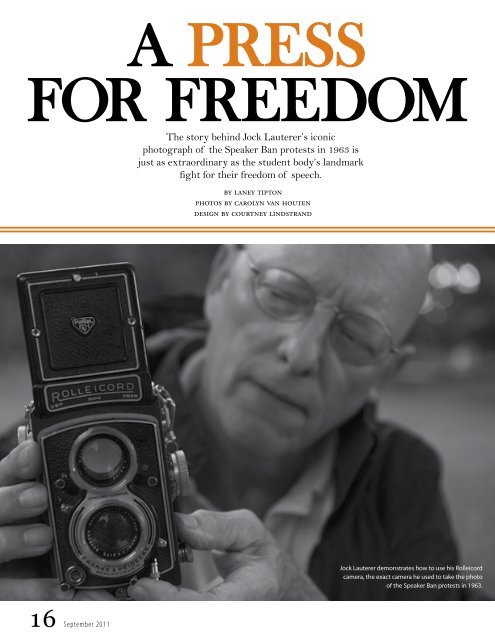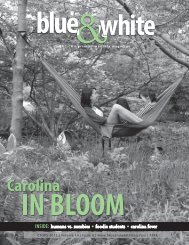then and now - Blue & White Online
then and now - Blue & White Online
then and now - Blue & White Online
Create successful ePaper yourself
Turn your PDF publications into a flip-book with our unique Google optimized e-Paper software.
A PRESSFOR FREEDOMThe story behind Jock Lauterer’s iconicphotograph of the Speaker Ban protests in 1963 isjust as extraordinary as the student body’s l<strong>and</strong>markfight for their freedom of speech.by laney tiptonphotos by carolyn van houtendesign by courtney lindstr<strong>and</strong>dDuring the 1960s, UNC-Chapel Hill students hadLauterer himself captured an iconic photograph documentingthis time of discord at UNC-CH. On June 26,bigger problems than belligerent pit preachers or studentbody president controversies. Students found themselves inthe center of unsettled national conflicts over civil rights,women’s rights <strong>and</strong> the Vietnam War.“It was a time of great unrest <strong>and</strong> social upheaval,” saysJock Lauterer, senior lecturer in the School of Journalism <strong>and</strong>Mass Communication. “And a fabulous time to be a photojournalist,because there was always something going on.”1963, the North Carolina General Assembly passed the Actto Regulate Visiting Speakers, better k<strong>now</strong>n as the SpeakerBan Law. The law made it illegal for anyone who was ak<strong>now</strong>n member of the Communist Party, or who was ak<strong>now</strong>n advocate of overthrowing the Constitution, to speakon the campus of a state university.To challenge the law, <strong>then</strong>-Student Body PresidentPaul Dickson invited Frank Wilkinson, a well-k<strong>now</strong>n FirstAmendment rights activist, to speak on campus. Lauterercaptured the two protesters, st<strong>and</strong>ing side by side whileWilkinson addressed the crowd, in what has become themost widely recognized photo from that day.“Jock’s photos really tell the story,” says Robert Dickson,Paul Dickson’s younger brother.When University officials wouldn’t allow Wilkinsonon University property, the demonstration, as shown inLauterer’s photographs, was moved to the edge of campuson Franklin Street. The speakers stood off-campus on thesidewalk as approximately 12,000 students sat in McCorklePlace behind a wall separating the boundaries with a signthat read “Dan Moore’s Chapel Hill Wall,” a nod to thegovernor of North Carolina at the time.Lauterer says the symbolic wall resonated deeply withthe students at the time because of the conflict surroundingthe Berlin Wall. He says it was emblematic of the separationbetween a free state <strong>and</strong> one that wasn’t.“We’re over here incarcerated mentally, if you will,” Lauterersays, looking back at the wall dividing campus from therest of Chapel Hill. “We can’t have certain speakers come tocampus? Come on, we’re about free speech <strong>and</strong> the educationof the emerging civic mind. How can you disallow a voice?It’s just counter to what a great university is all about.”The Speaker Ban Law was passed in Lauterer’s junioryear. He was a veteran photographer with the Daily Tar Heel<strong>and</strong> at the time, he lived in an apartment on HendersonStreet.The best part about his location, according to Lauterer,was that he had a perfect view of Franklin Street <strong>and</strong>, on thatday, a perfect view of the demonstration.Lauterer says this demonstration was different because ithad a locus—an absolute focal point. It didn’t move aroundlike other demonstrations he had covered.“I took a picture from my apartment window, but itwas far away,” Lauterer says. “It just kind of didn’t get it. Icouldn’t really figure out how to get the scale of the thing.”He went to Franklin Street hoping for a better angle just asthe demonstration was starting. He looked up <strong>and</strong> saw a tree,which is still there today, <strong>and</strong> decided to climb it.“I just said, you k<strong>now</strong>, I used to climb trees as a kid, so Iclambered up there with my clunky old camera.”That day, Lauterer was shooting with a 2 ¼ Rolleicordcamera, which he describes as “one of those funky old thingsyou look down into. It’s got two lenses on the front. It’s astrange-looking beast, but it has a big negative, which is whythose images are so crystal clear.”He realized that nobody else from the media had his view.“I was in the catbird’s seat,” he says. “It don’t get no betterthan that.”Lauterer says that when you capture a photograph thatbecomes iconic, you don’t realize it when you take it.“You k<strong>now</strong>, it’s not that great a photograph,” Lauterer says.“I would say that from the very outset. But, it just happened tocatch a very important, decisive moment in the history of thisUniversity intellectually—<strong>and</strong> certainly when it comes to freespeech.”Be that as it may, this photo became an emblem for freespeech activism. Part of the reason, Lauterer says, is because ofthe presence of Paul Dickson, who he describes as a ‘sparkplug’in getting the law repealed.Dickson worked with UNC-CH’s Students for a DemocraticSociety to get speakers Wilkinson <strong>and</strong> Herbert Apthekerto come to campus <strong>and</strong> hold the demonstration. This eventwas the basis of what eventually turned into a lawsuit, led byDickson, against Chancellor J. Carlyle Sitterson. The lawsuitspent two years under consideration at the Federal DistrictCourt in Greensboro before being decided in Dickson’sfavor: The Speaker Ban Law of 1963 <strong>and</strong> policy were deemedunconstitutional.Dickson died in an automobile accident in 1972, but hismemory <strong>and</strong> an appreciation for what he did for the campushave not been lost. His brother, Robert, <strong>and</strong> sister, Anne DicksonFogelman, are making sure it won’t be for a long time.In January 2010, the siblings approached William Friday,Jock Lauterer demonstrates how to use his Rolleicordcamera, the exact camera he used to take the photoof the Speaker Ban protests in 1963.The original, <strong>and</strong> <strong>now</strong> iconic, SpeakerBan photo that Lauterer took fromhis position in a nearby tree.photo credit: Jock Lauterer16 September 2011 www.blue<strong>and</strong>whitemag.com 17



